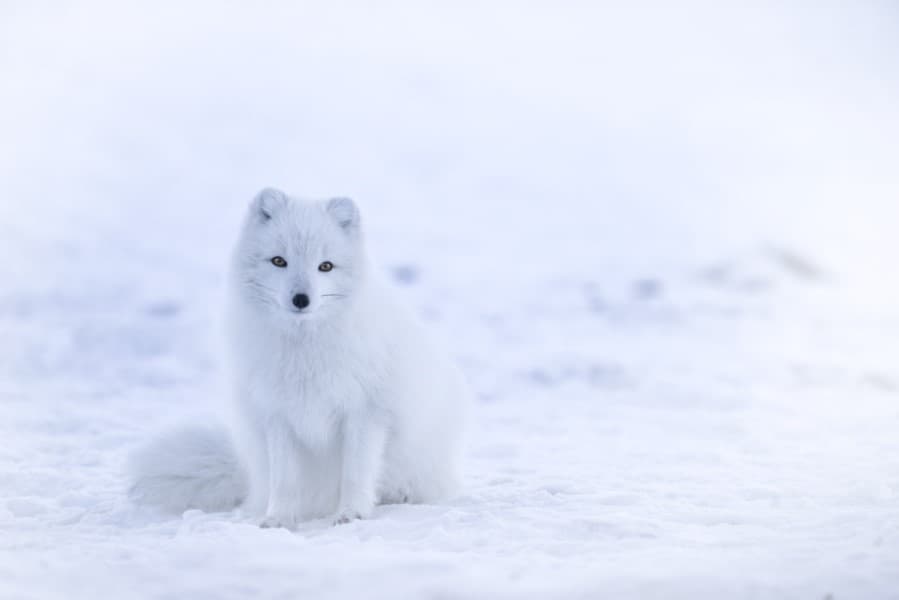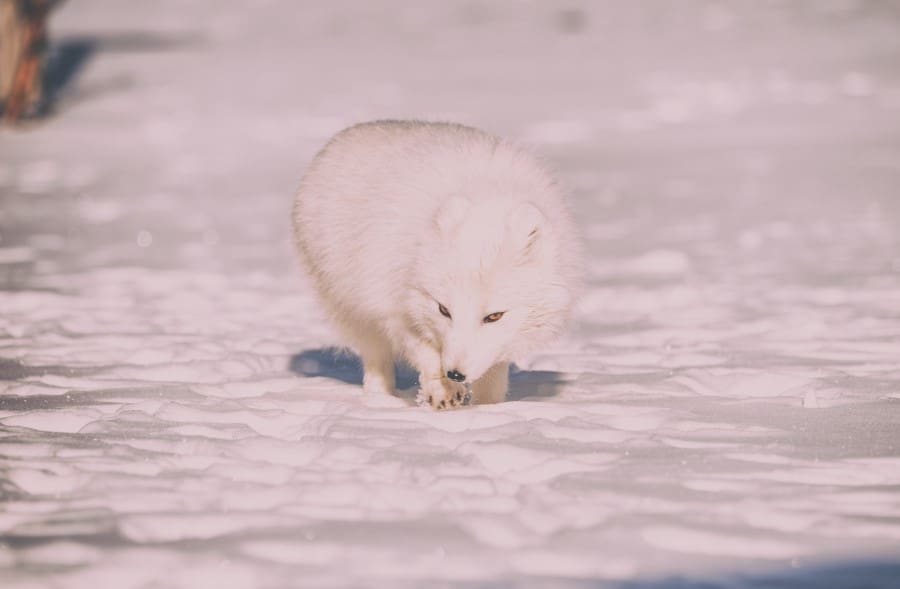Wondering what an arctic fox does in the winter? Here we answer the hibernation and survival habits of an arctic fox during winter.
As arctic foxes live in the icy tundra, you may think of them as being creatures that hibernate. In this article, we’re going to discuss arctic foxes’ hibernation habits – also known as snow fox. If they do hibernate, what they do, why they do it, and more arctic fox hibernation facts.
Does the arctic fox hibernate? An arctic fox does not hibernate. It has both the food it needs and the ability to physically transform to survive winter. If its main food source in winter such as lemmings becomes scarce, it may move to other regions. During winter the arctic fox sleeps, shivers, and licks its feet to stay warm.
Winter may not always be a cool and cozy season for all animals. While we only know a few animals that hibernate and stay active in winter, many animals are left unknown as to what they do in winter.
Especially when it comes to animals that live in the driest deserts and the coldest lands, there is little research known about their habits.
This is because reaching and monitoring these animals is difficult – as they live in weather or climate conditions that humans find it difficult to bear for any length of time – sufficiently enough to study them.
So much of what we know about animals like the arctic fox is from fragments of information scientists have obtained, along with some educated guesswork.
Arctic fox locations
The arctic fox is a common animal living in some of the coldest parts of the world – the entire Arctic tundra, through Alaska, Canada, Greenland, Russia, Norway, Scandinavia, and even Iceland.
Living in such harsh arctic conditions throughout the year raises questions not only regarding the general movements and habitat of the arctic fox but also around arctic fox hibernation and if the arctic fox hibernates.
So let’s dive into more details about how arctic foxes survive winter, do they hibernate or not, if they don’t what do they do, and many more.
Does the arctic fox hibernate?
Arctic foxes don’t hibernate. The reason why many animals hibernate in winter is because of the scarcity of food sources. When food becomes scarce it’s hard for animals to stay active as they don’t have the energy, this is, in fact, the main reason why animals hibernate – to find warmer places to stay, conserve energy and wait out the winter until food becomes abundant again.
This is the same for many similar animals who live in cold lands, they hibernate in winter because they’re unable to hunt their main source of food to provide them with energy.
But this is not the case for arctic foxes who can still find and prey on food underneath the snow in the winter.
However, during winter arctic foxes do sometimes move to other regions when and if the population of their prey reduces or fluctuates in the winter.
Where do arctic foxes live in the winter?
In winter, arctic foxes live either in dens in between rocky outcrops or hollow mounds at a cliff base, or in stumpy knolls at a height of around 3 to 15 feet above the tundra.
These dens are usually complex and can often have 4 to 8 entrances that can reach anywhere up to 300 square feet. However, strangely arctic foxes live in dens that can provide shelter for multiple generations of foxes.
In summer arctic foxes move around in the tundra at the edge of forests. Whereas in winter they roam more on ice floes. Because of this usually, during winter, it’s hard to spot arctic foxes on ice floes as their white fur serves as camouflage.

What do arctic foxes eat during winter?
During winter, arctic foxes mostly eat lemmings, since lemmings are generally in plentifully supply, along with eggs left by other animals, carrions of animals killed by winter, ringed seal pups and if food is particularly scarce, they’ll eat feces.
To locate prey moving through the tunnels underneath the snow, arctic foxes use their sharp sense of smell and hearing.
Here’s the full list of what arctic foxes eat.
How do they look in winter?
Arctic foxes truly take a great transformation during winter. This is because they are dimorphic which means they can develop two phases of coats which are brown or white. One can easily spot these changes in the color of the coat from summer to winter.
In summer arctic fox fur takes on a fawn-colored and brown fur effect – usually in early July.
When winter approaches they begin to regrow their bright white coat. Their fur also takes on a transformation from thick to thin, which can make them look larger and bulkier, with more furry tails.
Because of this body transformation, arctic foxes become much more adapted to their surroundings and climate, which is actually a means of preparing for the winter.
Arctic foxes physically transform for winter
To help survive the winter, the arctic fox undergoes a number of physical transformations. This happens naturally during the period before winter fully sets in. Let’s go over the transformations…
Increased body fat
During summer arctic foxes look skinny with only 6% making up their mass of body fat. However, when winter begins, they begin laying down greater amounts of fat stores, they can accumulate from 6% to 30%.
By the end of winter, they can actually look larger and plumper than at the start.

Increased fur
As well as what happens with their fat retention, their fur increases 140% in multiple layers on their bodies during winter.
Extra fur also grows around their feet, which gives them added heat insulation against the cold ground. And their furry tails are again a great source of heat insulation. The furry tail also acts as a mattress and shield to protect these foxes on cold and windy nights.
Low surface area
Additional to the above transformations, the arctic fox has another permanent advantage on its side.
Arctic foxes also have small ears close to the body along with a short muzzle that helps to minimize the surface area preventing heat loss. They also have hair on the bottoms of their paws, which makes them possible to walk on ice along with insulation.
However, despite these physical transformations, there are several other mechanisms arctic foxes use to survive this cold season.
Having the ability to live in temperatures that reach –20°F and lower, arctic foxes are able to maintain their core temperature due to several mechanisms they use to survive winter. So let’s look at how arctic foxes survive winter…
How arctic foxes survive in winter
To identify how animals survive cold environments like the arctic, a measurement called lower critical temperature is used. This is the temperature where an animal will have to use some mechanism – or start physically working hard to stay warm during more extreme cold temperatures.
Usually, the lower the critical temperature is, the less the animals have to work hard to stay warm. There are a variety of mechanisms that animals use to survive such as lower critical temperatures such as burning fat and shivering – which helps keep them warm.
When talking specifically about the arctic fox, they are among those that have the lowest – lower critical temperatures.
In an examination arctic foxes were put in an environment where temperatures could be controlled. At around -58°F to –76°F the fox went to sleep while maintaining its body temperature steadily.
When the temperature was -94°F the fox licked their feet for half an hour, slept for an hour, and also shivered. And when the temperature reached –112°F, the fox shivered for the first five minutes but their body temperature remained the same for an hour.
Learning resources
We’ve found the ideal resources to continue your learning both at home and at school. Help support our efforts for wildlife causes and keep this site working for nature.
Arctic Fox – Amazing Pictures and Interesting Facts
A wonderful book, to teach children more about arctic foxes. Containing all the information you need about arctic foxes, snow foxes. Including their anatomy, diet, habitat, reproduction process, behavior, social life, health, hunting, and more. All are presented in an easy-to-understand format so you and your kids can learn about these fascinating animals in a fun way. available on Amazon.
To finish
We hope this has been useful in understanding more about the arctic fox habits during winter. They do not hibernate as such but have other mechanisms that enable them to face the harsh tundra climate and continue to survive and thrive. Here are some related articles to move on to next.
This content has been checked and verified by a qualified veterinary practitioner. The article has been reviewed by our editorial board and has been approved for publication in accordance with our editorial policy.
